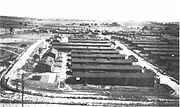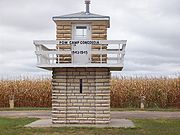
Camp Concordia
Encyclopedia

Prisoner-of-war camp
A prisoner-of-war camp is a site for the containment of combatants captured by their enemy in time of war, and is similar to an internment camp which is used for civilian populations. A prisoner of war is generally a soldier, sailor, or airman who is imprisoned by an enemy power during or...
that operated from 1943-1945. Its location is two miles north and one mile east of Concordia, Kansas
Concordia, Kansas
Concordia is a city in and the county seat of Cloud County, Kansas, United States. Located on the Republican River in the Smoky Hills region of the Great Plains, Concordia was founded in 1871 and is an economic and cultural center in north-central Kansas...
. The camp was used primarily for German
Germany
Germany , officially the Federal Republic of Germany , is a federal parliamentary republic in Europe. The country consists of 16 states while the capital and largest city is Berlin. Germany covers an area of 357,021 km2 and has a largely temperate seasonal climate...
army
Army
An army An army An army (from Latin arma "arms, weapons" via Old French armée, "armed" (feminine), in the broadest sense, is the land-based military of a nation or state. It may also include other branches of the military such as the air force via means of aviation corps...
prisoners during World War II
World War II
World War II, or the Second World War , was a global conflict lasting from 1939 to 1945, involving most of the world's nations—including all of the great powers—eventually forming two opposing military alliances: the Allies and the Axis...
who were captured in battles that took place in Africa
Africa
Africa is the world's second largest and second most populous continent, after Asia. At about 30.2 million km² including adjacent islands, it covers 6% of the Earth's total surface area and 20.4% of the total land area...
.
Camp Concordia was the largest Kansas
Kansas
Kansas is a US state located in the Midwestern United States. It is named after the Kansas River which flows through it, which in turn was named after the Kansa Native American tribe, which inhabited the area. The tribe's name is often said to mean "people of the wind" or "people of the south...
camp, holding over 4,000 prisoners (some sources cite as high as 8,000 prisoners). The camp consisted of a complex of 300 buildings and was staffed by 800 United States
United States
The United States of America is a federal constitutional republic comprising fifty states and a federal district...
soldiers.
Daily life
The prisoners arrived at Camp Concordia by train. Authorities believed the soldiers could provide useful labor for agriculture, and, almost immediately, the Germans started working with local farmers.Interactions between prisoners
At least two reported cases of executions are recorded, both were made by prisoners on fellow prisoners (some of whom were GestapoGestapo
The Gestapo was the official secret police of Nazi Germany. Beginning on 20 April 1934, it was under the administration of the SS leader Heinrich Himmler in his position as Chief of German Police...
agents. When conclusive evidice arose, the offenders were tried and sentenced to the federal penetentiary at Leavenworth.
Interaction between locals
"Difficulties between POWsPrisoner of war
A prisoner of war or enemy prisoner of war is a person, whether civilian or combatant, who is held in custody by an enemy power during or immediately after an armed conflict...
and local residents were few, and in fact friendships formed," stated Lowell May, president of the camp's preservation society. "Only a handful of escape attempts occurred, none successful." Life at the camp was easy compared with the war in Europe. Prisoners played outdoor sports, listened to band performances and took courses offered by the University of Kansas
University of Kansas
The University of Kansas is a public research university and the largest university in the state of Kansas. KU campuses are located in Lawrence, Wichita, Overland Park, and Kansas City, Kansas with the main campus being located in Lawrence on Mount Oread, the highest point in Lawrence. The...
.
Famous prisoners
- Harald DeilmannHarald DeilmannHarald Deilmann was a German architect.Born in Gladbeck, Westphalia, Deilmann was best known for his work on public spaces, such as opera houses and museums, throughout Germany and worldwide...
, architect and author. - Reinhard MohnReinhard MohnReinhard Mohn was a German businessman who turned Bertelsmann, a "provincial, war-shattered German publisher", into the sixth largest media conglomerate in the world.-Early life:...
, owner of the transnational media corporation Bertelsmann AG - Karl Dietrich BracherKarl Dietrich BracherKarl Dietrich Bracher is a German political scientist and historian of the Weimar Republic and Nazi Germany. Born in Stuttgart, Bracher was awarded a Ph.D. in the Classics by the University of Tübingen in 1948 and subsequently studied at Harvard University from 1949 to 1950...
, historian.
Return to Germany
The prisoners headed back to Germany in the autumn of 1945, some of them harboring pleasant memories of Kansas. Franz Kramer of GundelfingenGundelfingen
Gundelfingen im Breisgau is a municipality directly north of the city Freiburg in Baden-Württemberg in southern Germany.Gundelfingen is one of the larger municipalities in the Breisgau-Hochschwarzwald district...
, Germany, said: "There was no reason to criticize American authorities. The prisoners felt that they were well treated. We learned a little of the American way of life and saw part of the vast country."
The camp today

Camp records have been transferred and maintained at the Cloud County Historical Museum
Cloud County Historical Museum
The Cloud County Historical Museum is located in Concordia, Kansas. The Museum preserves and exhibits objects and documents of historical items representing early-day Kansas...
in Concordia. On display at the museum are also many items of interest about Camp Concordia including several original paintings created by prisoners at Camp Concordia.
Further reading
- Bell, Rachel Lowrey (1998a). A Proud Past... A Pictorial History of Concordia, Kansas, Marceline, Missouri: D-Books Publishing.
- Carlson, Lewis H., 1997, We Were Each Other’s Prisoners. Basic Books, New York.
- Emery, Janet Pease (1970a). It Takes People to Make a Town, Salina, Kansas: Arrow Printing Company. Library of Congress number 75-135688.
- Krammer, Arnold, 1979, Nazi Prisoners of War in America. Stein and Day, New York.
- May, Lowell A., 1995, Camp Concordia: German POWs in the Midwest. Sunflower University Press, Manhattan, Kansas.
- Thompson, Glenn, 1993, Prisoners on the Plains: German POWs in America. Phelps County Historical Society, Holdrege, Nebraska.

